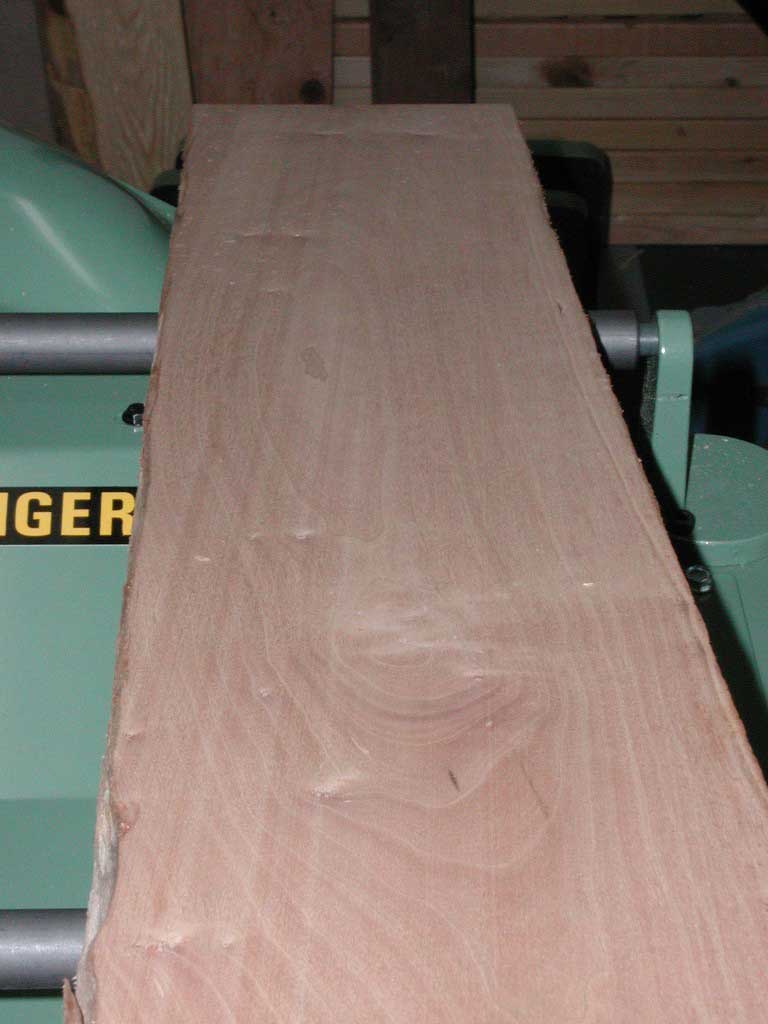Question
I purchased several General machines; a table saw 350, General Intl 12" jointer and a General Intl 15" planer. I am very happy with the table saw and jointer, but pretty unhappy with the planer. There must be thousands of these machines out there made in Taiwan and imported by General Intl, Jet, Powermatic, Shop Fox, Grizzly, etc.
Below are the results of a planed piece of cherry, with new knives I purchased from Freud. Iím not sure what else I can do with this machine as I have gone over it with a fine tooth comb. I have adjusted everything four or five times now and can probably do it in my sleep. Everything is to manufactures specifics. I get a little snipe, and I can live with that, but the cherry doesnít look that well, especially for new knives. Does anyone have any thoughts?

Forum Responses
(Solid Wood Machining Forum)
From contributor F:
Itís not the same looking at the photo as it would be to see it live, but from what I can see it looks like I can see white fuzz type lines or streaks running down along the length of the board. I have a pretty good planer (high RPM, slow feed), but it doesnít take very many feet of hardwood (especially maple) before those dull streaks start showing up.
An unfortunate fact about a lot of wood working cutting tools is that they donít necessarily come from the manufacturer tuned up or honed to perfection. I know a lot of carpenters who have never used a truly sharp chisel in their lives because they donít come that way from the store. The end users have to flatten and polish the back themselves and hone the bevel on stones, even right off the store shelf, and the same goes for hand planes.
Freud grinds a nice, pretty straight bevel on a set of new knives, but they donít hone the bevel or polish the back. I donít hone my planer knives - I sometimes reserve a side of the knives for finish passes.
I end up using scrapers and sanding before I do any finishing, and until the knives are so dull they start leaving a lot of little beads. I finish the boards with the best finish I can get from the good side of the knives. I think the guys that are doing a lot of millwork where their product is S4S footage have ďon machine" knife grinders and the have special clearance angles for certain woods and they also will do a honing right before the finish pass. They donít have time to sand.
It looks to me like your knives are not quite sharp enough for the glass finish you desire. Unless there are heavy mill marks that are not coming through in the photo, I think your planer is tuned correctly. The cure for heavy washboard mill marks is a slower rate of feed.
If you really need a good finish try polishing the backs of your knives on .375" thick float glass and fine wet or dry type sandpaper. Hone the bevel on the same thing or a sharpening stone that has a true surface on it.
If you are using straight HSS knives are you running two, three, or four knives in the head? Regardless of how many knives you are using only one makes the final cut, but the closer the others are to the cutting circle of that one finishing knife the cooler it will stay thus lasting longer.
Also, what angle are your knives ground to? I have found through repeated attempts that a 12 to 15 degree angle lasts longer and you are able to go from a hardwood such as maple to softwood like poplar with ease. Looking at the picture it appears to me that the burr is still on the knives, thus leaving the undesirable lines that you have. A little honing should take care of that for you.
The bed rollers just add to the problem. As the board clears the infeed bed roller, it drops back down on the bed, only .002-.003, but it makes a difference. An 8 foot outfeed roller table running very slightly uphill will help keep the very end of the board down when it clears the hold down roller on the infeed side, helping a little more on the snip. The planners are not $3,000 machines, but have been around 20 years and sold in every color of machine paint available.
Contributor B - I did not check the moisture in the cherry, it has been sitting in my heated garage for about a year and a half. I probably need to get a moisture meter at some point. I don't have a wide belt or drum sander yet.
Contributor R - I have the bed rollers at .001 above the table, and have tried them .001 below as well, and no difference. The weird thing about all of these 15" machines is that they are probably coming out of the same manufacturer in Taiwan. They have different specifics for adjusting the infeed, outfeed and chip breaker. Some say .020 below the cutting arc and other machines are supposed to be adjusted to .040? I have tried both, and still havenít had very good results. I think the knives are bad, that is the only thing that I have not been able to adjust yet.
Chatter is caused by something being out of balance. The head will take on an egg shape and there you have it. You could also have a head that was not properly balanced at the factory. The knives must also not only be properly sharpened, but also balanced. Sounds to me you don't have enough chip collection, or else a bad planner head.